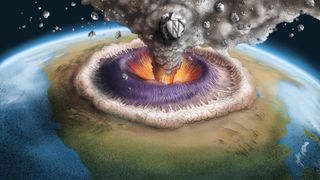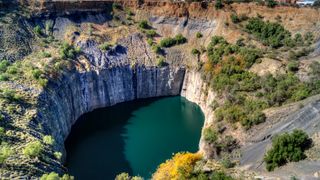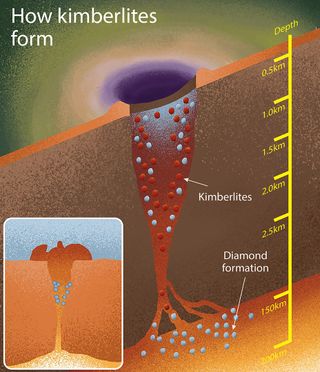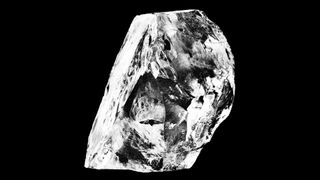Diamonds seem to reach Earth’s surface in massive volcanic eruptions when supercontinents break up, and they form when continents come together.

Diamonds erupt at the surface of the planet when supercontinents break up. Studying these sparkly gems can reveal secrets about our planet’s deep history. (Image credit: Rory McNicol for Live Science)
In the twilight of the Cretaceous, 86 million years ago, a volcanic fissure in what is now South Africa rumbled to life. Below the surface, magma from hundreds of miles down shot upward as fast as a car on the autobahn — if that car were barreling through solid rock — chewing up rocks and minerals and carrying them toward the surface in a reverse avalanche.
What this looked like on the surface is lost to history, but it may have been as dramatic as the eruption of Mount Vesuvius. What it left behind was a series of carrot-shaped, igneous-rock-filled tubes under low, weathered white hills.
In 1869, a shepherd’s discovery of a huge, sparkly rock on a nearby riverbank would catapult this unassuming landscape into infamy. The rock was an enormous diamond that would eventually be known as the Star of Africa, and the white hills hid what would become the Kimberley Mine, the epicenter of South Africa’s diamond rush and quite possibly the largest hole on Earth ever dug out by hand.
Thanks to the Kimberley Mine, often called “The Big Hole,” the formations where diamonds are found are now known as kimberlites. The formations are sprinkled across the globe, from Ukraine to Siberia to Western Australia, but they’re relatively small and rare. What makes them special is that their magmas come from very deep down. There are still questions about precisely how deep, but they are known to arise from beneath the bases of continents at the border of the hot, convecting mantle. Some may originate even deeper, at the transition between the upper and lower mantle.
Related: What’s inside Earth?

As such, these magmas tap into very deep, very ancient rock, and they interact with other processes that occur only in the deep Earth — namely, the formation of diamonds. To crystallize plain-old carbon into hard, sparkly diamond requires great pressure, so these gems form at least 93 miles (150 kilometers) down, in the deepest layers of the lithosphere, the scientific term for the crust and relatively rigid upper mantle. Some, known as sub-lithospheric diamonds, form even deeper, down to around 435 miles (700 km). Kimberlites, on their eruptive journeys to the surface, catch diamonds and drag them into the upper crust, delivering them relatively unscathed and sometimes even containing pockets of fluid from the mantle itself.
Researchers have long known that as tectonic plates grind under one another, they drag down carbon from the surface to depths where it can crystallize into diamond. Now, they’re starting to see that what goes down must (sometimes) come up, and that this reappearance of carbon — now pressed into glittering gems — is also tied to the movements of tectonic plates. In particular, diamonds seem to erupt when supercontinents break apart.
“While these are different processes, together the diamonds and kimberlite can inform us about the life cycle of supercontinent times,” said Suzette Timmerman, a geologist at the University of Bern in Switzerland who studies diamonds.
Coming to the surface
No one has ever seen a kimberlite eruption firsthand. There have been very few in the past 50 million years, and the most recent possible eruption, in the Igwisi Hills of Tanzania, occurred over 10,000 years ago. Not only that, but the main material in kimberlite, the mineral olivine, weathers away quickly on the surface, said Hugo Olierook, a research fellow at Curtin University in Australia.
This makes studying kimberlites challenging. Scientists are perplexed, for example, about the chemistry of the original source of the melted rock in the mantle, as well as about how kimberlites manage to punch through the stable cores of what geoscientists call “cratons” — the thick interior parts of continents that usually resist disruption.
A handful of recent studies are sketching out a new explanation for why this happens. The first clue is timing. It’s long been noted that pulses of kimberlite activity seem to correspond with the approximate timing of supercontinent break-ups, said Kelly Russell, a volcanologist at the University of British Columbia in Canada. A 2018 study led by Sebastian Tappe, a geoscientist at The Arctic University of Norway, took a global look at this coincidence of timing and found that it up: There was a spike in kimberlite eruptions around the breakup of the supercontinent Nuna some 1.2 billion years ago to 1 billion years ago.
Another pulse occurred between 600 million and 500 million years ago, coinciding with the breakup of the supercontinent Rodinia, according to the 2018 research, followed by a smaller pulse between 400 million and 350 million years ago. But the most prolific period, accounting for 62.5% of all known kimberlites, occurred between 250 million and 50 million years ago. That range happens to coincide with the breakup of the supercontinent Pangaea. To some researchers, this suggests that supercontinent cycles are crucial for kimberlite eruptions.
“The breakup of these continents are fundamental to getting these diamonds up from these deep depths,” Olierook told Live Science.
Olierook and his team recently analyzed the ages of unusual pink diamonds from a formation in western Australia and found they likely came to the surface about 1.3 billion years ago, within the window of Nuna breaking up. The new discovery links diamonds to the stretching of continental crust, Olierook said.
“It’s those extensional forces that allow those little pockets of deep-seated magma to rise to the top,” he said.
The march of the kimberlites

The tricky question, though, is how this happens. To get a kimberlite, there are two key ingredients: deep, melted rock rich in fluids, and a continental disruption that may bring that melt to the surface. No one knows what causes the formation of the kimberlite melt, but the chemistry of kimberlites is very different from that of the mantle rock it melts from. Kimberlites are also rich in volatiles such as water and carbon dioxide, which is what makes them so buoyant and high-velocity. They shoot through the crust like Champagne rushing through an uncorked bottle, ascending at up to 83 mph (134 km/h). For comparison, the magmas that flow out of the volcanoes in places like Hawaii max out at around 13.5 mph (21.7 km/h).
An August 2023 study used computer modeling to figure out how kimberlites can burst through the thick hearts of continents. The researchers found that the process of rifting, in which continental crust pulls apart, was key. The stretching creates peaks and valleys at both the surface and base of the continent. At the base, these jagged edges allow warm mantle materials to rise, and then cool and fall, creating eddies. These eddies mix materials from the base of the continents, making the frothy, buoyant kimberlites, which can then shoot up toward the surface, carrying any diamonds they might happen to run into on their way up.
This process began right where the continent was rifting apart, but modeling showed that these jagged regions of eddy formation destabilized neighboring areas on the craton, creating the same dynamics closer and closer to the continental interior. The result was a pattern of kimberlite eruptions starting near the rift zone but gradually marching into areas of stable crust. This slow march explains why kimberlite pulses don’t peak until a bit after a big breakup begins, said Thomas Gernon, a geologist at the University of Southampton in the U.K. who led the study.
“You will see these peaks of kimberlites seem to happen after big supercontinents have broken up,” he said. “But it’s not just a one-hit thing; it’s something that may last quite a long time after supercontinent breakups.”

Kimberlites may be quite common at the bases of continents, said Tappe, whose 2018 study on kimberlites and supercontinent breakups came to similar conclusions as Gernon’s. Tappe and his team found that these melts may have been particularly prominent during the breakup of Pangaea, because the mantle, which has been slowly cooling since Earth solidified, reached just the right temperature around 250 million years ago to have kimberlite-type melts dominate. Prior to that period, the rocks in that region may have been too hot to get that combination of melt and volatile material that makes kimberlites so eruptive. This may be one reason why most kimberlite diamond mines date from the breakup of Pangaea.
Messages in a diamond
As the dull, white hills that once covered the Kimberley Mine attest, kimberlites themselves can’t say much about the mantle where they originated. They weather away within a few years, losing much of what makes them interesting on a chemical level. However, the diamonds carried within kimberlites are a different story. They have their own formation histories that don’t coincide with the formation of the kimberlite magma itself. But their chance meetings hundreds of miles below the surface mean that bits of the mantle that would never otherwise see daylight can reach human hands.
These bits are microscopic pockets of fluid from the time the diamonds formed. Many of these “inclusions” date back hundreds of millions of years, while a few specimens count their ages in the billions. Plus, some of these diamonds form very deep in the mantle, so certain stones can carry materials from as far down as the boundary between the mantle and the core.
“Only in kimberlites we can see samples coming from 400 kilometers [250 miles], even down to 2,000 kilometers [1,200 miles],” said Maya Kopylova, a professor of diamond exploration at the University of British Columbia. “No other magmas on Earth do that.”
Related: What’s the deepest-forming gemstone on Earth?

While the eruption of diamonds can trace a story of supercontinent breakup, their formation may also provide a clue to how continents come together. In a study published in October 2023 in the journal Nature, Timmerman studied diamonds from Brazil and Guinea that formed between 186 and 434 miles deep (300 to 700 km). By dating fluid inclusions within the diamonds, Timmerman and her colleagues estimated that the diamonds formed around 650 million years ago, when the supercontinent Gondwana was forming. The diamonds probably stuck to the base of the continent and sat there for millennia until Gondwana broke up during the Cretaceous period and kimberlites brought them to surface, Timmerman told Live Science.
What was important about these superdeep diamonds, Timmerman said, was that they helped explain how continents grow. Supercontinents are built when oceanic crust pushes under continental crust. This process, called subduction, tugs two continents on opposite sides of an ocean closer together. This same subduction brings carbon to the depths, where it can be compressed into diamond.
Down in the mantle, bits of these subducting plates can become buoyant and rise back up, carrying superdeep diamonds with them, Timmerman explained. This material may stick to the bases of continents for millennia, helping them grow from below. It may also explain how superdeep diamonds land in a place where a kimberlite can catch them.
“Deep diamonds can inform us more about subduction processes, mantle convection, liquid-rock interactions and other processes happening below the crust during supercontinent cycles,” Timmerman said.
There are many other questions to answer, she added. For instance, scientists still don’t know how subducted plates change the bases of supercontinents and whether that affects how long a supercontinent lasts before breaking up. Another open question is whether this recycled crustal material influences when and where kimberlite magmas form.
Ancient diamonds may also tell us about other milestones in Earth’s chaotic history.
Some diamonds are forged from carbon that was incorporated into Earth upon its formation, Olierook said, while others form from carbon from ancient life, dragged down along with slabs of subducted crust. It’s possible to tell which process formed the diamonds by analyzing the molecular structure of the carbon within diamond inclusions. These inclusions can thus hold secrets about hazy numbers in Earth history, such as when widespread subduction began or when life in the oceans became prevalent.
But to get at those answers, researchers will need to get better at figuring out how old diamonds are. And they’ll need more diamonds that are both ancient and from the deepest depths.
“Going back in time from the most recent supercontinent breakup to the ones before that,” Olierook said, “I strongly suspect there are still lots to be discovered.”










